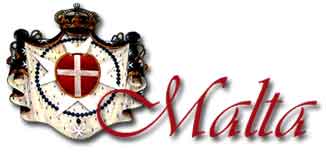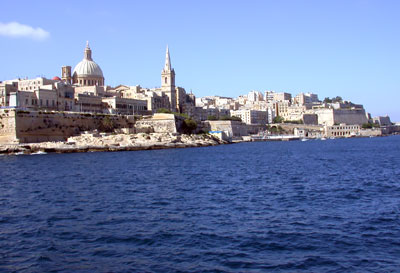Monday 10 June: Valletta

Feeling better, we hopped on a bus for Valletta. Buses are cheap and will take you anywhere in Malta. Some are old and can be a bit uncomfortable on bumpy roads, and none are air conditioned. But they seem to run on a reliable schedule. Unlike the vaporetti in Venice, these are no bargain if you buy a one-day pass. You would have to take ten separate rides a day to come out ahead. The main bus terminus in Valletta is just outside the city gate. It is laid out in a huge circle with specified parking areas for each bus, depending on its route. With a route map in hand, one can find the right bus for the desired destination. Most Maltese speak both English and Maltese, and perhaps some Italian. Language did not prove to be a problem for us.
I wouldn't call the sunrise spectacular; but the new hotels and condos to the south, and the hills behind them looked pretty at this time of morning. Almost all buildings in Malta are of the soft pale honey-colored globigerina sandstone, which is so common on the island that it is the cheapest building material. Earthquake safe? The locals say yes and point out they haven't had a major earthquake in 400 years. However, the last one in 1693 was a doozy and leveled almost every building on the islands. From what we saw of Maltese building practices, we wouldn't want to be here when a big quake hits. The island's landscape is in no way remarkable. There are no rivers or mountains, and the land is mildly contoured, neither flat nor hilly. Little color except for the pinks, reds or whites of the oleander bushes. Now, in the late spring, there is much green; but this will soon fade in the scorching summer sun.
From the bus terminal, we walked through the city gate into old Valletta. The city was founded in 1566, just after the Turks had lifted their "Great Siege" and skulked home. It is named in honor of the hero of that battle, Jean de la Valette. One of Europe's first planned cities, it was laid out in a rectangular grid of straight streets crossed at right angles by other streets, a revolutionary idea at the time. Valletta is surrounded on three sides by water and edged by thick fortified walls which are as old as the city itself.
We looked into the Jesuits Church, a small quiet sanctuary on a side street. Then we visited the Grand Masters Palace and Armory. Built in 1571, it was home to the Grand Masters of the Order of Saint John (the Knights of Malta) until the order died out in 1798. It subsequently was the official residence of the British governors, and today is the Presidential Office and Parliament House. It is a palace of great splendor and wealth. Inside, the marble corridors are lined with suits of armor and portraits of Grand Masters and other aristocrats. The Throne Room has a spectacular frieze, painted in the 1570's, depicting 12 important incidents of the Great Siege. Off to the side are the impressive Red and Yellow Rooms, and the State Dining Room. Nearby, in the Tapestry Chamber hangs a set of Gobelin tapestries. Across a courtyard, one can visit the Armory. When a knight died, his armor and arms stayed with the Order and although much has been lost over the years, the collection is still huge. Some of the pieces were ceremonial, and thus richly crafted; others were obviously used in combat, including some captured from the Turks in 1565.
Fort St Elmo, at the entrance to the Grand Harbor, was closed to the public this day, a big disappointment. I had read The Great Siege by Ernle Bradford, a wonderfully readable account of the Ottoman invasion of 1565, and had anticipated walking where the tenacious but doomed Knights held out against overwhelming odds. But it was not to be and we had to be content to look over the thick walls into an empty fort.
We continued our walk around the walls and then back uphill into the city center to St Paul's Anglican Cathedral. This church was built in the mid 19th century and its 65 meter spire can be seen from afar. Hanging in the sanctuary were flags from all of England's World War II allies. We met a man who has worked in the church for many years but was ready to leave Malta with his family. The constant winds on the island were wearing him down.
Around the corner is the controversial Carmelite Church. Originally built in 1573, it was heavily damaged in World War II. When it was rebuilt, a new structure of much greater proportions was built around the old church, including a massive dome which is just a bit higher than its Anglican neighbor's spire. Some have said the huge dome was designed to put the Anglicans "in their place." Be that as if may, the dome and spire together dominate Valletta's skyline and are visible from far out at sea. Interestingly, the rebuilt interior of the church is very light and free of ornamentation, unusual for a Maltese Catholic church.
Close by is the Manoel Theater, built in 1731 and possibly the third oldest in Europe. Over the years it led a checkered life and fell into neglect; but when the Royal Opera House was destroyed in the war, the Manoel underwent a restoration. Today, it is an elegant jewel. We were disappointed that no tours were being given today and that there were no events scheduled while we were in town. But we did have lunch in the theater's courtyard café.
The highlight of the day was our visit to St John's Co-Cathedral. The church was completed in 1578 and other sections were added as late as 1736. The somewhat severe exterior doesn't prepare you for the opulence and splendor of the interior. The Knights of Malta was, above all, a religious order, and no expense was spared in proclaiming the glory of God. It is a shrine to the Knights, with many sons of Europe's noble families from the 16th to 18th centuries buried here. It is a magnificent church.
The floor catches the eye immediately. Spanning the entire length of the nave is a vast pavement of multicolored marble slabs. Over 400 memorials to knights, admirals, warriors, and nobles which tell the great stories of their achievements. Created from marble of many hues by many craftsmen, they are adorned with coats of arms, heraldic devices, figures of death, skeletons, angels, instruments of war, and much more. Awesome.
The great vaulted ceiling is filled with paintings by Mattia Preti depicting 18 episodes in the life of St John the Baptist. The high altar, sanctuary, nine chapels, and the sacristy are equally opulent. In the oratory hangs Caravaggio's Beheading of St John the Baptist. The whole effect is breathtaking.
The church museum is highlighted by 29 Flemish tapestries created about 1700. There are
also church vestments and illuminated choral books.
